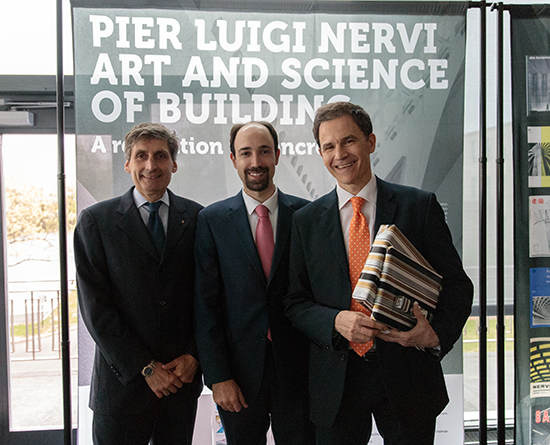Manufacturing the Impossible with Cement
New Shapes Beyond Formwork
Amanda Allekotte
Dec 15, 2020

Source: Lehigh University
The collaboration’s flagship project focuses on developing a new methodology for 3D printing concrete components and structures. The most common techniques for 3D printing concrete consist of extruding premixed low-slump concrete through a large nozzle attached to a robotic arm. While this approach was instrumental in popularizing concrete 3D printing and led to the first simple 3D printed structures, it has several drawbacks. Mainly, the process deposits subsequent layers, one over the other, with the previous layers supporting the new ones. This layering prevents the creation of openings and overhangs. The resulting surfaces have visible layers, which some consider less aesthetically pleasing.
To address these drawbacks, Lehigh and Buzzi Unicem are pioneering a technique that consists of precisely jetting microdroplets of a water-based liquid on extremely thin layers of cement and fine aggregates. The printer automatically spreads layer after layer of the dry mix, and the automated print-head selectively activates the cement hydration in the locations that are needed for that layer by jetting droplets only in those regions. The inert cement and aggregates serve as support for the following layers, allowing the creation of openings, cavities, and overhangs. At the end of the printing process, the dry mix that did not react is easily collected and reused.
The process is completely automated and free from the constraints of traditional formwork, which also enables manufacturing geometries that could not be formed with traditional casting. The geometric precision is millimetric and the smooth surface finish results in manufactured objects with a more appealing look. Ultimately, the new technique increases the sustainability of cement construction by allowing for material to be used only in regions of the structural components where it will be most effective—a goal that is easily achieved by metal structures, but much more difficult to achieve with traditional formwork. The ability to reuse all the cement powder that did not react during the 3D printing process also contributes to the overall sustainability of the process.
The team includes Dr. Paolo Bocchini, Dr. John Fox, and Dr. Clay Naito, as well as students Joseph Ingaglio, Xingjian Wang, and Trevor Belinsky from Lehigh University. The Lehigh team members work with several scientists and engineers from Buzzi Unicem, coordinated by Michele Maranzana, vice president of Manufacturing Processes. To develop the new process, the team first focused on developing an effective manufacturing protocol and selecting the appropriate materials. After a broad range of tests, Buzzi Unicem’s CSA cement emerged as the best option for the binder, due to its fast set time (which confers strength during the printing process), ability to rapidly absorb water (which prevents water from “bleeding” into locations where hydration should not occur), and ability to preserve geometric accuracy.
The results obtained with Buzzi Unicem’s CSA cement were recently published in Construction and Building Materials, a prestigious international journal, and will serve as the starting point for developing a specific 3D printing cement mix that Buzzi Unicem USA may bring to market. The team is currently aiming to increase the size of produced objects by using larger printers and modular printing of components assembled with post-tensioning cables. The team is also investigating a novel way of applying reinforcement with the same geometric freedom that 3D printing offers to concrete. Another goal is to develop a new design paradigm that embraces this unprecedented geometric freedom not only for architectural decoration, but also for structural optimization. To this end, the team is investigating techniques for topology optimization.
While the methodology is not yet ready to be deployed in practice, it has the potential to revolutionize both the precast industry and the entire construction sector. “Effectively, free-form concrete with freeform reinforcement will constitute a new construction material,” Bocchini says. “This will require a new design paradigm and leverages a modern, efficient, and sustainable manufacturing process.” “New shapes that do not need formwork will enable visionary designs and cost savings,” Maranzana says.
